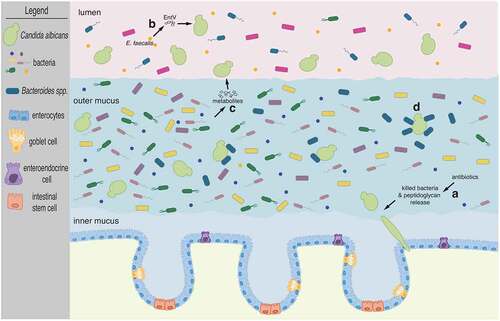Figures & data
Figure 1. The fungus C. albicans inhabits the mammalian gut along with numerous and diverse bacterial species. Cartoon depicts the mammalian colon. The inner mucus layer which is largely devoid of microbes separates intestinal epithelial cells from the microbiota. C. albicans cells adopt the oval-shaped ‘yeast’ morphology and occupy the outer mucus layer as well as the intestinal lumen. Illustrated are four instances of documented bacterial interactions with C. albicans: (a) β-lactam antibiotic treatment promotes C. albicans filamentation due to the release of bacterial peptidoglycan subunits in the intestinal lumen. Candida hyphae disseminate from the gut seeding bloodstream infections. (b) The bacterium E. faecalis secretes the EntV peptide which inhibits hyphal morphogenesis. (c) Multiple bacterial species can provide a wide range of metabolic products which can alter C. albicans proliferation, albeit by unknown mechanisms. And (d) Bacteroides spp. closely associate with C. albicans cells in the outer mucus layer and can feed on mannan, a complex carbohydrate decorating the cell surface of the fungus. See main text for further details

DATA AVAILABILITY STATEMENT
Data sharing is not applicable to this article as no new data were created or analyzed in this study.
